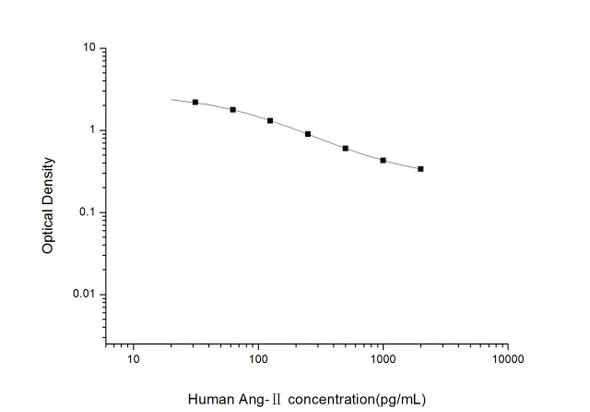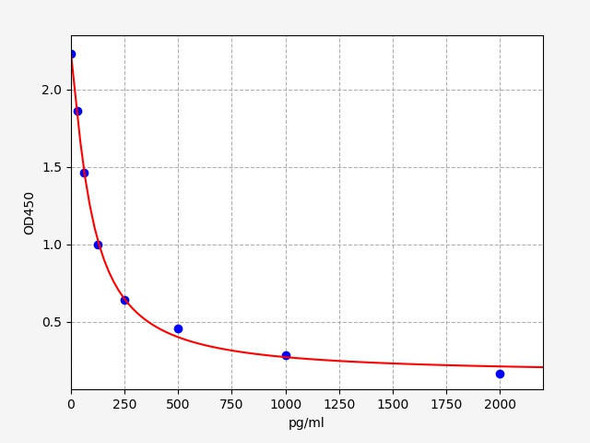Human Cell Biology ELISA Kits 5
Human ANG II R1(Angiotensin II Receptor 1)ELISA Kit (HUES01549)
- SKU:
- HUES01549
- Product Type:
- ELISA Kit
- Size:
- 96 Assays
- Uniprot:
- P30556
- Sensitivity:
- 0.09ng/mL
- Range:
- 0.16-10ng/mL
- ELISA Type:
- Sandwich
- Synonyms:
- AT1R, AG2S, AG2-S, AGTR1A, AGTR1B, AT1, AT1B, AT2R1, AT2-R1, AT2R1A, AT2R1B, HAT1R, Angiotensin II receptor, type 1 , AT1 receptor,
- Reactivity:
- Human
- Sample Type:
- Serum, plasma and other biological fluids
- Research Area:
- Cell Biology
Description
| Assay type: | Sandwich |
| Format: | 96T |
| Assay time: | 4.5h |
| Reactivity: | Human |
| Detection Method: | Colormetric |
| Detection Range: | 0.16-10 ng/mL |
| Sensitivity: | 0.10 ng/mL |
| Sample Volume Required Per Well: | 100µL |
| Sample Type: | Serum, plasma and other biological fluids |
| Specificity: | This kit recognizes Human ANG II R1 in samples. No significant cross-reactivity or interference between Human ANG II R1 and analogues was observed. |
This ELISA kit uses Sandwich-ELISA as the method. The micro ELISA plate provided in this kit has been pre-coated with an antibody specific to Human ANGIIR1. Standards or samples are added to the appropriate micro ELISA plate wells and combined with the specific antibody. Then a biotinylated detection antibody specific for Human ANGIIR1 and Avidin-Horseradish Peroxidase (HRP) conjugate are added to each micro plate well successively and incubated. Free components are washed away. The substrate solution is added to each well. Only those wells that contain Human ANGIIR1, biotinylated detection antibody and Avidin-HRP conjugate will appear blue in color. The enzyme-substrate reaction is terminated by adding Stop Solution and the color turns yellow. The optical density (OD) is measured spectrophotometrically at a wavelength of 450 nm ± 2 nm. The OD value is proportional to the concentration of Human ANGIIR1. The concentration of Human ANGIIR1 in samples can be calculated by comparing the OD of the samples to the standard curve.
| UniProt Protein Function: | AT1: receptor for angiotensin II. Angiotensin II is a potent vasopressor hormone and a primary regulator of aldosterone secretion. It is an important effector controlling blood pressure and volume in the cardiovascular system. Mediates the major cardiovascular effects of angiotensin II. May play role in the generation of reperfusion arrhythmias following restoration of blood flow to ischemic or infarcted myocardium. Mediates its action by association with G proteins that activate a phosphatidylinositol-calcium second messenger system. |
| UniProt Protein Details: | Protein type:Membrane protein, integral; GPCR, family 1; Membrane protein, multi-pass; Receptor, GPCR Chromosomal Location of Human Ortholog: 3q24 Cellular Component: integral to plasma membrane; integral to membrane; plasma membrane Molecular Function:protein binding; angiotensin type II receptor activity; protein heterodimerization activity; angiotensin type I receptor activity; bradykinin receptor binding Biological Process: elevation of cytosolic calcium ion concentration during G-protein signaling, coupled to IP3 second messenger (phospholipase C activating); regulation of vasodilation; positive regulation of cellular protein metabolic process; renin-angiotensin regulation of aldosterone production; calcium-mediated signaling; regulation of systemic arterial blood pressure by renin-angiotensin; Rho protein signal transduction; regulation of cell proliferation; G-protein coupled receptor protein signaling pathway; elevation of cytosolic calcium ion concentration; renin-angiotensin regulation of blood vessel size; regulation of vasoconstriction; regulation of inflammatory response; G-protein signaling, coupled to IP3 second messenger (phospholipase C activating); regulation of cell growth; kidney development; positive regulation of phospholipase A2 activity; positive regulation of inflammatory response; positive regulation of NAD(P)H oxidase activity Disease: Renal Tubular Dysgenesis; Hypertension, Essential |
| NCBI Summary: | Angiotensin II is a potent vasopressor hormone and a primary regulator of aldosterone secretion. It is an important effector controlling blood pressure and volume in the cardiovascular system. It acts through at least two types of receptors. This gene encodes the type 1 receptor which is thought to mediate the major cardiovascular effects of angiotensin II. This gene may play a role in the generation of reperfusion arrhythmias following restoration of blood flow to ischemic or infarcted myocardium. It was previously thought that a related gene, denoted as AGTR1B, existed; however, it is now believed that there is only one type 1 receptor gene in humans. Multiple alternatively spliced transcript variants have been reported for this gene. [provided by RefSeq, Jul 2012] |
| UniProt Code: | P30556 |
| NCBI GenInfo Identifier: | 231519 |
| NCBI Gene ID: | 185 |
| NCBI Accession: | P30556. 1 |
| UniProt Secondary Accession: | P30556,Q13725, Q8TBK4, |
| UniProt Related Accession: | P30556 |
| Molecular Weight: | 41kDa |
| NCBI Full Name: | Type-1 angiotensin II receptor |
| NCBI Synonym Full Names: | angiotensin II receptor, type 1 |
| NCBI Official Symbol: | AGTR1 |
| NCBI Official Synonym Symbols: | AT1; AG2S; AT1B; AT1R; AT1AR; AT1BR; AT2R1; HAT1R; AGTR1B |
| NCBI Protein Information: | type-1 angiotensin II receptor; type-1B angiotensin II receptor |
| UniProt Protein Name: | Type-1 angiotensin II receptor |
| UniProt Synonym Protein Names: | AT1AR; AT1BR; Angiotensin II type-1 receptor; AT1 |
| Protein Family: | Type-1 angiotensin II receptor |
| UniProt Gene Name: | AGTR1 |
| UniProt Entry Name: | AGTR1_HUMAN |
As the OD values of the standard curve may vary according to the conditions of the actual assay performance (e. g. operator, pipetting technique, washing technique or temperature effects), the operator should establish a standard curve for each test. Typical standard curve and data is provided below for reference only.
| Concentration (ng/mL) | O.D | Average | Corrected |
| 10 | 2.475 2.503 | 2.489 | 2.424 |
| 5 | 1.754 1.776 | 1.765 | 1.7 |
| 2.5 | 1.064 1.05 | 1.057 | 0.992 |
| 1.25 | 0.504 0.532 | 0.518 | 0.453 |
| 0.63 | 0.283 0.255 | 0.269 | 0.204 |
| 0.32 | 0.19 0.168 | 0.179 | 0.114 |
| 0.16 | 0.113 0.131 | 0.122 | 0.057 |
| 0 | 0.065 0.065 | 0.065 | -- |
Precision
Intra-assay Precision (Precision within an assay): 3 samples with low, mid range and high level Human ANG II R1 were tested 20 times on one plate, respectively.
Inter-assay Precision (Precision between assays): 3 samples with low, mid range and high level Human ANG II R1 were tested on 3 different plates, 20 replicates in each plate.
| Intra-assay Precision | Inter-assay Precision | |||||
| Sample | 1 | 2 | 3 | 1 | 2 | 3 |
| n | 20 | 20 | 20 | 20 | 20 | 20 |
| Mean (ng/mL) | 0.52 | 1.03 | 4.33 | 0.53 | 1.07 | 4.76 |
| Standard deviation | 0.03 | 0.06 | 0.16 | 0.03 | 0.06 | 0.15 |
| C V (%) | 5.77 | 5.83 | 3.70 | 5.66 | 5.61 | 3.15 |
Recovery
The recovery of Human ANG II R1 spiked at three different levels in samples throughout the range of the assay was evaluated in various matrices.
| Sample Type | Range (%) | Average Recovery (%) |
| Serum (n=5) | 90-107 | 98 |
| EDTA plasma (n=5) | 95-106 | 100 |
| Cell culture media (n=5) | 96-111 | 101 |
Linearity
Samples were spiked with high concentrations of Human ANG II R1 and diluted with Reference Standard & Sample Diluent to produce samples with values within the range of the assay.
| Serum (n=5) | EDTA plasma (n=5) | Cell culture media (n=5) | ||
| 1:2 | Range (%) | 86-98 | 88-102 | 87-99 |
| Average (%) | 92 | 94 | 93 | |
| 1:4 | Range (%) | 88-99 | 86-98 | 84-98 |
| Average (%) | 94 | 93 | 90 | |
| 1:8 | Range (%) | 94-106 | 85-98 | 86-97 |
| Average (%) | 99 | 91 | 92 | |
| 1:16 | Range (%) | 91-103 | 83-99 | 88-102 |
| Average (%) | 96 | 90 | 95 |
An unopened kit can be stored at 4°C for 1 month. If the kit is not used within 1 month, store the items separately according to the following conditions once the kit is received.
| Item | Specifications | Storage |
| Micro ELISA Plate(Dismountable) | 8 wells ×12 strips | -20°C, 6 months |
| Reference Standard | 2 vials | |
| Concentrated Biotinylated Detection Ab (100×) | 1 vial, 120 µL | |
| Concentrated HRP Conjugate (100×) | 1 vial, 120 µL | -20°C(shading light), 6 months |
| Reference Standard & Sample Diluent | 1 vial, 20 mL | 4°C, 6 months |
| Biotinylated Detection Ab Diluent | 1 vial, 14 mL | |
| HRP Conjugate Diluent | 1 vial, 14 mL | |
| Concentrated Wash Buffer (25×) | 1 vial, 30 mL | |
| Substrate Reagent | 1 vial, 10 mL | 4°C(shading light) |
| Stop Solution | 1 vial, 10 mL | 4°C |
| Plate Sealer | 5 pieces | |
| Product Description | 1 copy | |
| Certificate of Analysis | 1 copy |
- Set standard, test sample and control (zero) wells on the pre-coated plate and record theirpositions. It is recommended to measure each standard and sample in duplicate. Note: addall solutions to the bottom of the plate wells while avoiding contact with the well walls. Ensuresolutions do not foam when adding to the wells.
- Aliquot 100 µL of standard solutions into the standard wells.
- Add 100 µL of Sample / Standard dilution buffer into the control (zero) well.
- Add 100 µL of properly diluted sample (serum, plasma, tissue homogenates and otherbiological fluids) into test sample wells.
- Cover the plate with the sealer provided in the kit and incubate for 90 min at 37 °C.
- Aspirate the liquid from each well, do not wash. Immediately add 100 µL of BiotinylatedDetection Ab working solution to each well. Cover the plate with a plate seal and gently mix. Incubate for 1 hour at 37 °C.
- Aspirate or decant the solution from the plate and add 350 µL of wash buffer to each welland incubate for 1-2 minutes at room temperature. Aspirate the solution from each well andclap the plate on absorbent filter paper to dry. Repeat this process 3 times. Note: a microplatewasher can be used in this step and other wash steps.
- Add 100 µL of HRP Conjugate working solution to each well. Cover with a plate seal andincubate for 30 min at 37 °C.
- Aspirate or decant the solution from each well. Repeat the wash process for five times asconducted in step 7.
- Add 90 µL of Substrate Reagent to each well. Cover with a new plate seal and incubate forapproximately 15 min at 37 °C. Protect the plate from light. Note: the reaction time can beshortened or extended according to the actual color change, but not by more than 30min.
- Add 50 µL of Stop Solution to each well. Note: Adding the stop solution should be done inthe same order as the substrate solution.
- Determine the optical density (OD value) of each well immediately with a microplate readerset at 450 nm.






